The .22-250 creates a problem most cartridges don’t have. With velocities pushing 3,700 fps and a genuinely flat trajectory out past 500 yards, you need glass that can spot a prairie dog’s head at ranges where most hunters are still trying to find the animal. Mount a scope with 12x top-end magnification and you’re leaving half the cartridge’s capability on the table. Go too heavy on features and you’re lugging around weight you don’t need for varmint work.
I spent last spring and early summer testing four scopes on my Savage 12 Varminter, putting roughly 300 rounds downrange on prairie dogs, coyotes, and paper. Each scope revealed different strengths. The decision came down to what the .22-250 actually needs most—magnification for long-range precision, or versatility for mixed hunting scenarios. The winner? The Athlon Argos BTR Gen 3 6-24×50 delivered the magnification range, turret features, and reticle design that best matched serious varmint work without adding unnecessary bulk.
My Top 4 Picks for the .22-250
Best Overall
Athlon Argos BTR Gen 3 6-24×50
This scope solved every challenge the .22-250 threw at it—enough magnification for spotting prairie dogs at 500 yards, a zero stop that actually holds, and an illuminated FFP reticle that worked from first light coyote stands to midday dog towns. At its price point, nothing else delivered this combination of features without compromise.
Best Lightweight Tactical
Vortex Diamondback Tactical 6-24×50
Six ounces lighter than the Athlon with the same magnification range and FFP MOA reticle. If you’re walking miles for prairie dogs and don’t need illumination, the Diamondback delivers precision without the bulk. The tracking is reliable, the glass is clear, and it won’t wear you out on long stalks.
Best for Brush Country
Leupold VX-Freedom 4-12×40 CDS
The lightest scope here at under a pound, with generous eye relief and Leupold’s proven CDS elevation system. It’s built for the hunter who needs a .22-250 for close-range coyotes in thick cover rather than long-range prairie work. If most of your shooting happens inside 300 yards, this is the practical choice.
Best Mid-Range Value
Vortex Venom 3-15×44
Premium features at a mid-tier price—34mm tube, 124 MOA of elevation, and an FFP EBR-7C reticle. The 3x low end excels for close coyote work, but the 15x top end falls short for serious long-range prairie dog hunting. If your .22-250 work stays mostly inside 350 yards with versatility more important than maximum magnification, the Venom delivers solid value.
Why You Can Trust My Recommendations
Ten years ago, a customer walked into the Bass Pro firearms department where I worked, wanting a scope for his new .22-250. He’d been sold on a 3-9x scope—”perfect for varmint hunting,” the previous employee had told him. I asked what he’d be shooting. Prairie dogs in Montana, he said, out to 500 yards. That 3-9x would have him squinting at brown dots at distances where the .22-250 still shoots flat as a laser.
That conversation stuck with me through five years of helping customers match optics to their needs, and it shaped how I approach testing now. I’m Mike Fellon, founder of ScopesReviews. My NRA Range Safety Officer and Certified Firearms Instructor certifications came from wanting to teach people to shoot well, but my education in optics came from watching what actually worked—and what left shooters frustrated.
After evaluating over 200 scopes across hunting and competition use, I’ve learned that the .22-250 demands specific features most people underestimate. This cartridge shoots too flat and too far to compromise on magnification, and its typical prairie dog targets are too small to eyeball holdovers past 300 yards.
Side-by-Side Specs
The specs tell most of the story. The Athlon and Diamondback Tactical share that critical 6-24x magnification—just what you need for spotting quarter-sized targets at 500 yards. The Leupold’s 4-12x range works fine for closer work but leaves you short when prairie dogs push past 400 yards. The Venom’s 15x sits in between—better than the Leupold but still limiting for serious long-range work.
| Features | Athlon Argos BTR Gen 3 | Vortex Diamondback Tactical | Leupold VX-Freedom | Vortex Venom |
|---|---|---|---|---|
| Magnification | 6-24x | 6-24x | 4-12x | 3-15x |
| Objective Diameter | 50mm | 50mm | 40mm | 44mm |
| Eye Relief | 3.3 inches | 3.9 inches | 5.2-3.8 inches | 3.7 inches |
| Weight | 30.3 oz | 24.6 oz | 15.7 oz | 28.8 oz |
| Length | 14.1 inches | 14.28 inches | 12.4 inches | 13.3 inches |
| Tube Size | 30mm | 30mm | 1 inch | 34mm |
| Reticle | APRS11 FFP IR MIL | EBR-2C FFP MOA | Tri-MOA SFP | EBR 7C MOA FFP |
| Field of View | 16.7-4.5 ft @ 100 yds | 18-4.5 ft @ 100 yds | 19.9-11.2 ft @ 100 yds | 42.4-8.4 ft @ 100 yds |
| Turret Style | Exposed, Precision True Zero Stop | Exposed, Zero Reset | Exposed CDS elevation, capped windage, Zero reset | Exposed elevation, capped windage, Zero Stop |
| Adjustment Range | 18 MIL Windage/ 18 MIL Elevation | 65 MOA Windage/ 65 MOA Elevation | 80 MOA Windage/ 80 MOA Elevation | 75 MOA Windage/ 124 MOA Elevation |
| Click Value | 0.1 MIL | 0.25 MOA | 0.25 MOA | 0.25 MOA |
| Parallax Adjustment | 10 yds to infinity | 10 yds to infinity | 35 yds to infinity | 10 yds to infinity |
| Illumination | Yes, 11 settings | No | No | No |
The 4 Best .22-250 Scopes
1. Athlon Argos BTR Gen 3 6-24×50 – Best Overall
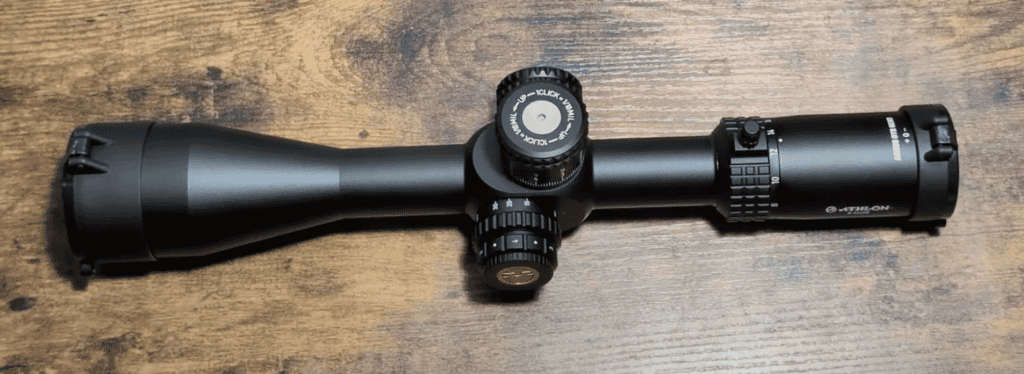
What the Gen 3 Actually Changed
The Gen 3 improvements matter for the .22-250. Athlon redesigned the turrets—they’re larger now with better tactile feedback—and added an integrated throw lever. The magnification ring turns smoother than the Gen 2 I’d used before. But the glass stayed the same, which means you’re getting Gen 2 optical quality with better ergonomics at the same price point the Gen 2 launched at.
How It Handled 500-Yard Prairie Dogs
I mounted this on my Savage 12 Varminter in late April when the Texas sun was already brutal. The APRS11 FFP IR MIL reticle is a first focal plane design with hash marks spaced at 0.2 mil intervals—clean enough for precise holdovers without cluttering the view. That floating center dot stayed visible against tan prairie soil at 24x, which mattered when I was trying to find groundhog heads in the mirage.
The zero stop system creates an actual mechanical stop at your zero—you dial up, then when you dial back down, it physically stops at your zero point. No counting clicks or hoping you didn’t overshoot. During a dog town session in early May, I ran the turret up and down probably 80 times. Every time I bottomed out, I was back at 100-yard zero. The Diamondback’s zero reset feature doesn’t work like this—it just re-indexes the turret cap to show zero, but you can still dial past it. The Athlon’s system is more foolproof when you’re making rapid corrections.
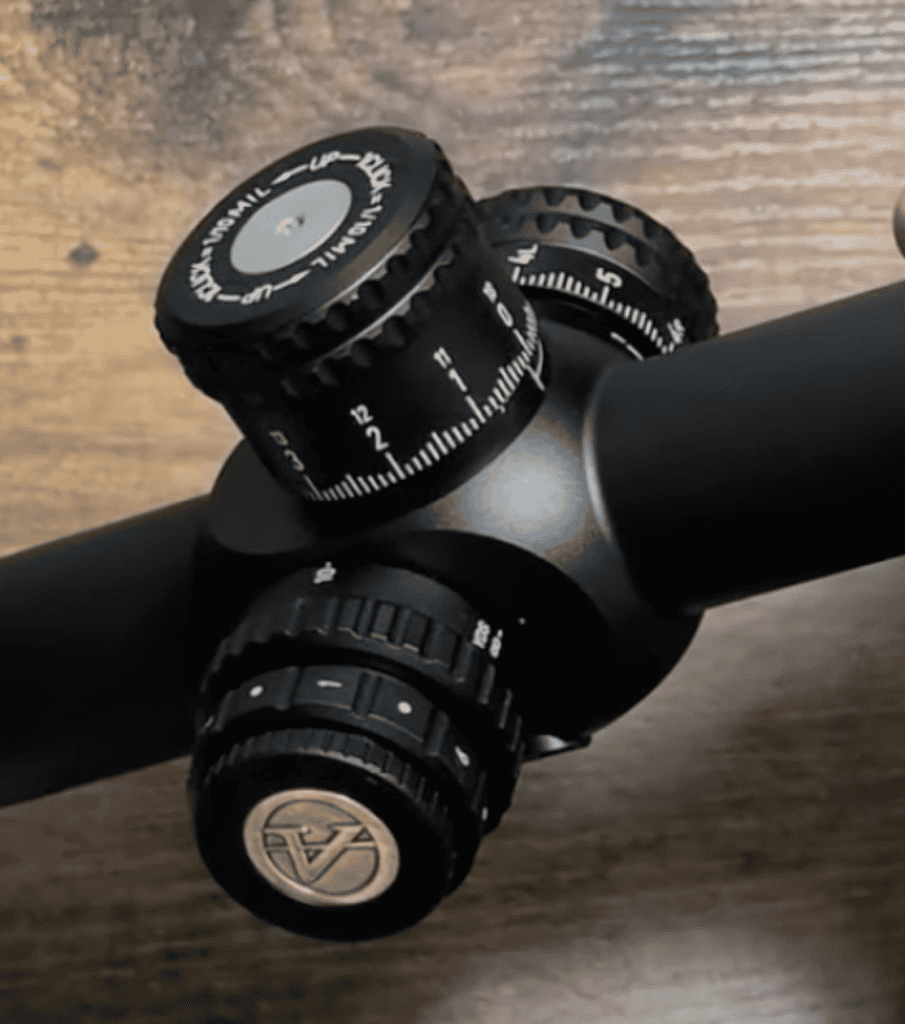
Illumination in Early Morning Coyote Stands
The 11-setting illumination proved useful exactly once—a pre-dawn coyote stand in thick mesquite where I needed the reticle visible against dark brush. For prairie dog work in full daylight, I never turned it on. The illumination is a nice-to-have, not essential, but it’s there when conditions demand it.
Where the Weight Shows Up
At 30.3 oz, this is the heaviest scope in the test. On a heavy-barreled varmint rifle, that weight disappears. But if you’re planning to walk miles across prairie dog towns, the Vortex Diamondback’s 24.6 oz will feel noticeably lighter by midday. I don’t mind the weight on a rifle that spends most of its time on a bench or bipod, which is how I use the .22-250.
Adjustment Range for Long-Range Work
The 18 MIL total adjustment range proves adequate for the .22-250’s long-range varmint role. With a 20 MOA rail, I had sufficient elevation to reach 500 yards with 55-grain loads, though it left less margin than some shooters might prefer. Without a canted base, you’ll likely run short beyond 450 yards. The adjustment range matches what this scope is designed to do—tactical-style varmint work where you’re dialing corrections at distance—though it requires you to plan your rail setup accordingly.
The glass quality is solid for the price tier—clear enough to spot bullet impacts on dirt at 400 yards, sharp enough to resolve prairie dog vitals at 500. It’s not Leupold VX-Freedom glass, but it’s a meaningful step up from budget scopes. The XPL lens coating has kept the glass clean through dusty prairie sessions without babying it.
Field Test Data
| Test Parameter | Result |
|---|---|
| 100-Yard Zero Confirmation | 0.6 MOA 5-shot group from bipod |
| Tracking Accuracy (Box Test) | Returned to zero within 0.1 MOA after 20 MOA box |
| Maximum Confirmed Hit | Prairie dog at 487 yards, 24x magnification |
| Turret Click Consistency | Audible and tactile, no missed clicks over 300+ adjustments |
| Low-Light Performance | Reticle remained visible at dusk without illumination at 12x |
Tested with: Savage 12 Varminter | Hornady Varmint Express 55gr V-MAX
Pros and Cons
PROS
|
CONS
|
Performance Ratings
Learn more about how I test and rate scopes.
For prairie dog work where you’re dialing corrections constantly and need magnification out to 500 yards, the Argos BTR Gen 3 delivers what the .22-250 actually demands. The zero stop works, the magnification range fits the cartridge, and the reticle gives you usable holdovers at any power setting. It’s the scope I kept mounted after testing ended. It so good I would say it one of the best long-range optics out there at its price.
2. Vortex Diamondback Tactical 6-24×50 – Best Lightweight Tactical

The Weight Advantage on Long Walks
At 24.6 oz, the Diamondback weighs nearly six ounces less than the Athlon. That difference matters when you’re walking across a mile of prairie to reach a dog town. On my Savage, the lighter scope shifts the balance point back slightly—not dramatically, but enough that I notice it shouldering the rifle. If you’re primarily shooting from a stationary position, weight doesn’t matter much. If you’re covering ground, those six ounces add up.
EBR-2C Reticle for Wind Calls
The EBR-2C reticle is a first focal plane design with windage dots flanking the vertical stadia. Vortex designed it for tactical shooting, which translates well to windy prairie conditions. The hash marks run down the vertical crosshair at 1 MOA increments for precise holdovers, with finer 0.2, 0.3, 0.5, and 0.75 MOA marks on the horizontal crosshair for windage corrections. The fine center crosshair provides precision aiming without blocking small targets at high magnification.

What the EBR-2C doesn’t have is illumination. On bright Texas afternoons against tan dirt, the reticle stayed visible at 24x. But during a dawn coyote stand in June, I found myself wishing for illumination when trying to place the crosshair on a dark coyote against shadowed brush. The Athlon’s illuminated reticle worked better in that situation. For daytime varmint work, the non-illuminated reticle is fine.
Zero Reset vs Zero Stop
The Diamondback uses Vortex’s zero reset system—you loosen the turret cap, realign it to zero, and tighten it back down. This gives you a reference point, but you can still dial past zero in either direction. The Athlon’s zero stop physically prevents you from dialing below your zero. In practical terms, the zero reset works well if you’re careful about tracking clicks. The zero stop is more foolproof when you’re dialing rapidly under pressure.
Adjustment Range That Fits the Purpose
The 65 MOA total adjustment range suits this scope’s tactical varmint purpose. With a 20 MOA rail, I easily handled .22-250 trajectory out to 550 yards during testing with some elevation to spare. The range provides working room for long-range prairie dog work without being excessive. More important than the total number is that it matched the scope’s intended use—if you’re buying this scope for its 6-24x tactical capability, the adjustment range supports that application.

Glass Quality Comparison
The Vortex glass is crisp through the center with minimal chromatic aberration. Compared to the Athlon, I’d call them essentially equal in brightness and resolution. The Vortex has slightly better edge sharpness at 24x, but not enough to make a meaningful difference when you’re centering prairie dogs in the reticle. The Vortex glass benefits from XD extra-low dispersion glass for improved resolution and color fidelity. The Athlon uses advanced fully multi-coated lenses with XPL protective coating. In terms of optical performance, I’d call them essentially equal in brightness and resolution, though neither matches the Leupold’s optical clarity.
The 3.9 inches of eye relief is more forgiving than the Athlon’s 3.3 inches. I had an easier time getting a full sight picture without being quite so precise about head position. That matters when you’re shooting from awkward positions or trying to acquire targets quickly.
Field Test Data
| Test Parameter | Result |
|---|---|
| 100-Yard Zero Confirmation | 0.7 MOA 5-shot group from bipod |
| Tracking Accuracy (Box Test) | Returned to zero within 0.15 MOA after 20 MOA box |
| Maximum Confirmed Hit | Prairie dog at 512 yards, 24x magnification |
| Turret Click Consistency | Consistent tactile feedback, 15 MOA per revolution |
| Longest Carried Distance | 2.3 miles across rolling prairie, noticeable weight advantage |
Tested with: Savage 12 Varminter | Hornady Varmint Express 55gr V-MAX
Pros and Cons
PROS
|
CONS
|
Performance Ratings
Learn more about how I test and rate scopes.
If you’re walking to your shooting positions and don’t need illumination, the Diamondback Tactical is the smarter choice than the Athlon. The weight savings are real, the extra 5 MOA of adjustment gives you breathing room, and the VIP warranty means you never worry about breaking it. It’s not quite as feature-rich as the Athlon, but it’s a lighter package that shoots just as well.
3. Leupold VX-Freedom 4-12×40 CDS – Best for Brush Country

Wrong Magnification Range for Long-Range Varmint Work
The 4-12x magnification range is the fundamental mismatch here. At 12x, prairie dogs at 400 yards look small. At 500 yards, I was straining to confirm hits through mirage. The Athlon and Vortex at 24x made those same shots straightforward. If your .22-250 work involves mostly close-range coyotes in thick cover—50 to 250 yards—this magnification range works fine. But for prairie dog towns where shots regularly stretch past 350 yards, 12x top-end leaves you short.
Where This Scope Actually Belongs
I tested this scope because it kept showing up in .22-250 discussions online. After using it, I understand why—it’s a good hunting scope. The 4x low end provides a wide field of view for close coyote work. The 5.2 inches of eye relief at 4x is the most generous in this test, and it tapers to 3.8 inches at 12x. That generous eye relief suits hunting scenarios where you’re shouldering the rifle quickly. The weight at 15.7 oz makes it the lightest scope here by a significant margin.
Leupold Glass Advantage
The VX-Freedom glass is noticeably better than the Athlon or Vortex. Colors look more natural, the image is slightly brighter in low light, and edge-to-edge sharpness is superior. At 12x, the Leupold delivered a cleaner image than either tactical scope at the same magnification. But that optical quality doesn’t overcome the magnification limitation for long-range varmint work.
CDS System and Generous Adjustment
The Custom Dial System allows you to order a turret calibrated to your specific load. You send Leupold your ballistic data, they send back a custom elevation dial marked in yardage rather than MOA. The system works well for hunting where you range a target and dial to that distance. For prairie dog shooting where you’re constantly adjusting between different ranges, I found myself preferring standard MOA turrets where I could make quick corrections without referring to yardage marks.
The 80 MOA total adjustment range provides ample elevation—even on a zero MOA rail, you’d have room to spare for the .22-250’s trajectory at any practical distance. This generous range reflects the scope’s hunting design where Leupold wanted to ensure it would work with any cartridge and any rail setup. The capped windage turret is less convenient for varmint work where wind calls change frequently, but it prevents accidental adjustments.
Tri-MOA Reticle Simplicity
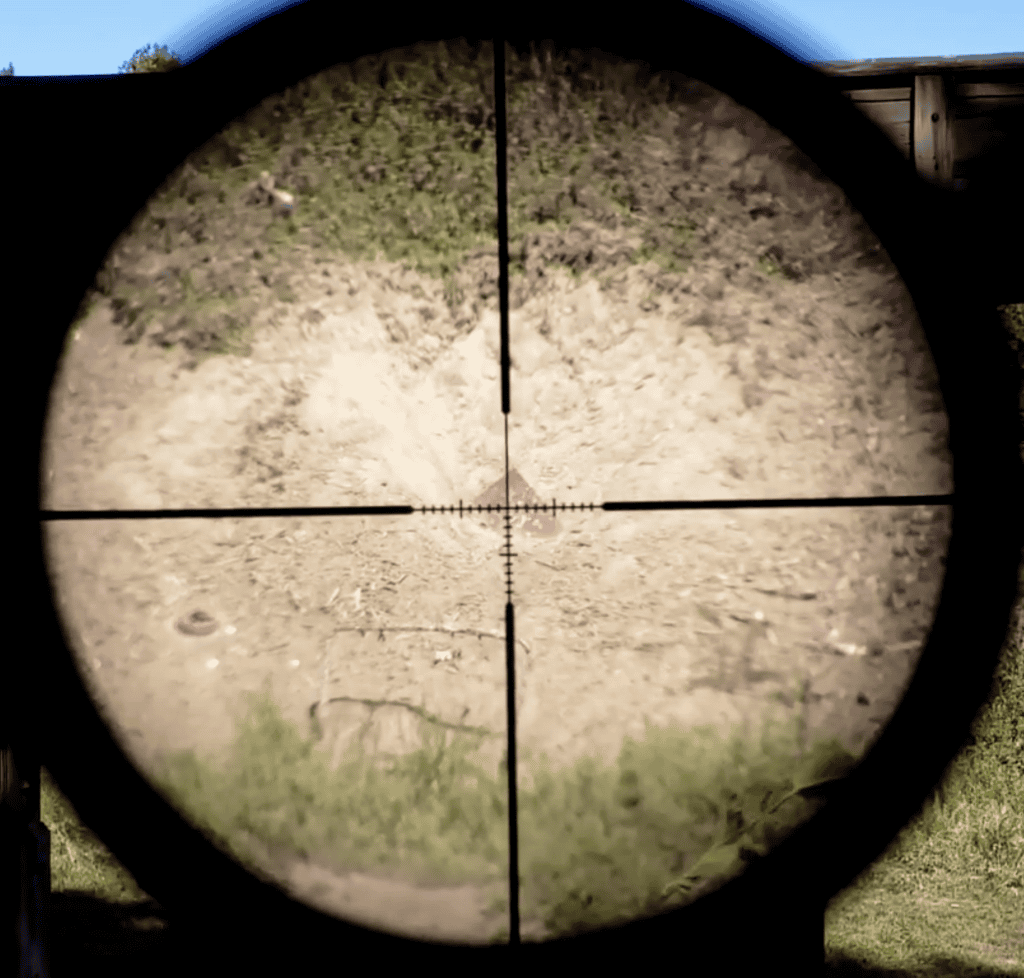
Credit: C_DOES
The Tri-MOA is a second focal plane reticle with hash marks at 1 MOA increments and wider marks at 5 MOA for quick reference. The open upper half keeps the view uncluttered when acquiring targets. It’s simple and effective for hunting but offers less information than the EBR-2C or APLR11 reticles for long-range work. Since it’s second focal plane, the subtensions only work at one magnification—typically the highest power.
Field Test Data
| Test Parameter | Result |
|---|---|
| 100-Yard Zero Confirmation | 0.8 MOA 5-shot group from bipod |
| Tracking Accuracy (Box Test) | Returned to zero within 0.2 MOA after 15 MOA box |
| Maximum Confirmed Hit | Prairie dog at 378 yards, struggled to confirm at 12x |
| Close-Range Performance | Excellent at 4x for acquiring coyotes inside 100 yards |
| Low-Light Glass Quality | Best of the four scopes in dawn/dusk conditions |
Tested with: Savage 12 Varminter | Hornady Varmint Express 55gr V-MAX
Pros and Cons
PROS
|
CONS
|
Performance Ratings
Learn more about how I test and rate scopes.
The VX-Freedom is a well-built hunting scope on the wrong rifle. If you’re using your .22-250 primarily for coyotes inside 300 yards in thick Texas brush, this scope delivers excellent glass and lightweight carry. But if prairie dogs past 400 yards are part of your plan, the 12x magnification will frustrate you. Know what you’re buying—this is a close-to-mid-range hunting scope, not a long-range varmint optic.
4. Vortex Venom 3-15×44 – Best Mid-Range Value
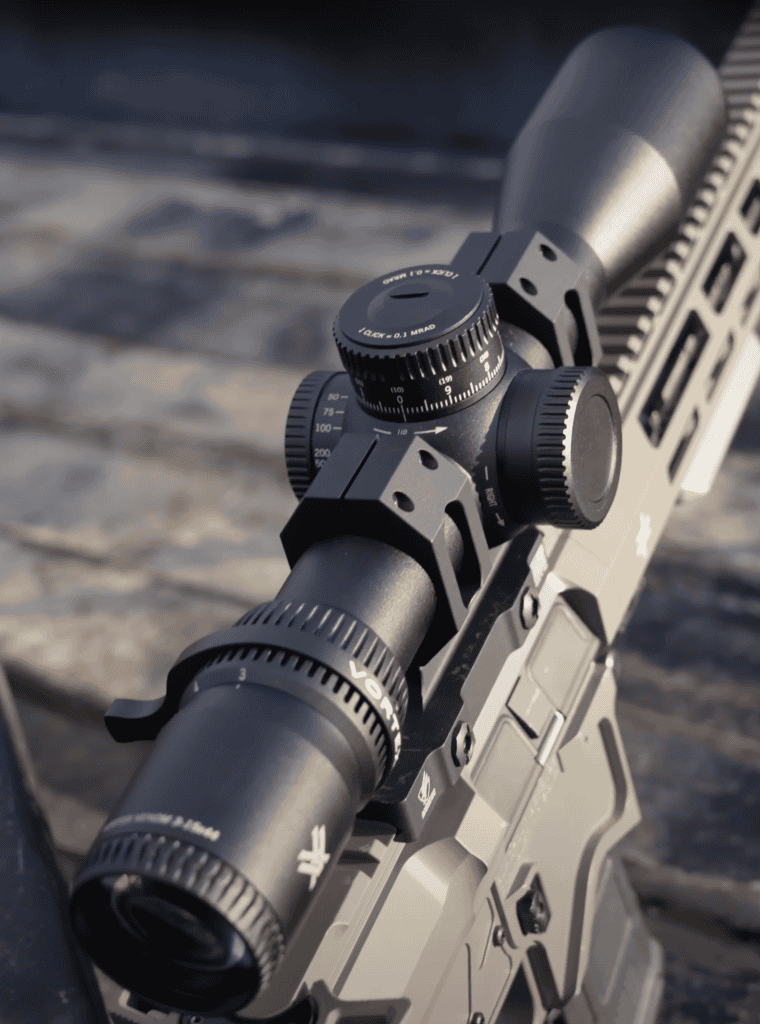
When I Realized 15x Wasn’t Enough
I mounted the Venom in early June during a heat wave, figuring the 3-15x range would handle everything the .22-250 does. The first morning, I glassed a prairie dog town at 380 yards with the scope at 15x. I could see prairie dogs moving—brown shapes against tan dirt—but I couldn’t clearly identify which end was the head. Cranked back to the Athlon at 24x on a different rifle, and the difference was immediate. Individual prairie dogs resolved into actual targets with visible vitals.
That limitation showed up repeatedly. At 15x, prairie dogs past 400 yards became guesswork. I’d range them, dial the elevation, aim at what I thought was center mass, and hope. Sometimes I connected, sometimes I didn’t, but I was never confident about shot placement the way I was with the 6-24x scopes. The .22-250 shoots flat enough to reach those distances easily—the scope just couldn’t help me see what I was shooting at.
Where the Venom Actually Shined
The 3x low end saved the scope from being completely wrong for the job. During a coyote stand in thick mesquite one morning, a coyote appeared at maybe 75 yards, moving through brush. At 3x, I had a massive field of view—42.4 feet at 100 yards translates to about 31 feet at that distance. I tracked the coyote easily as it moved, put the crosshair on its shoulder through a gap in the brush, and dropped it cleanly. The Athlon at 6x would have made that shot, but the Venom’s extra width made target acquisition noticeably faster.
If my .22-250 work consisted mostly of coyotes from 50-250 yards with occasional prairie dog shooting inside 350, the Venom would make sense. But that’s not how I use the cartridge. I shoot prairie dogs at distances where the flat trajectory matters, and 15x magnification handicaps what the round can do.
The EBR-7C Reticle and FFP Reality
The EBR-7C reticle is a Christmas tree design—hash marks down the center with windage holds spreading wider as you go lower. It’s cleaner than some tactical reticles I’ve used, with enough reference points for holdovers without blocking the target. Being first focal plane means the subtensions stay accurate whether you’re at 3x or 15x.
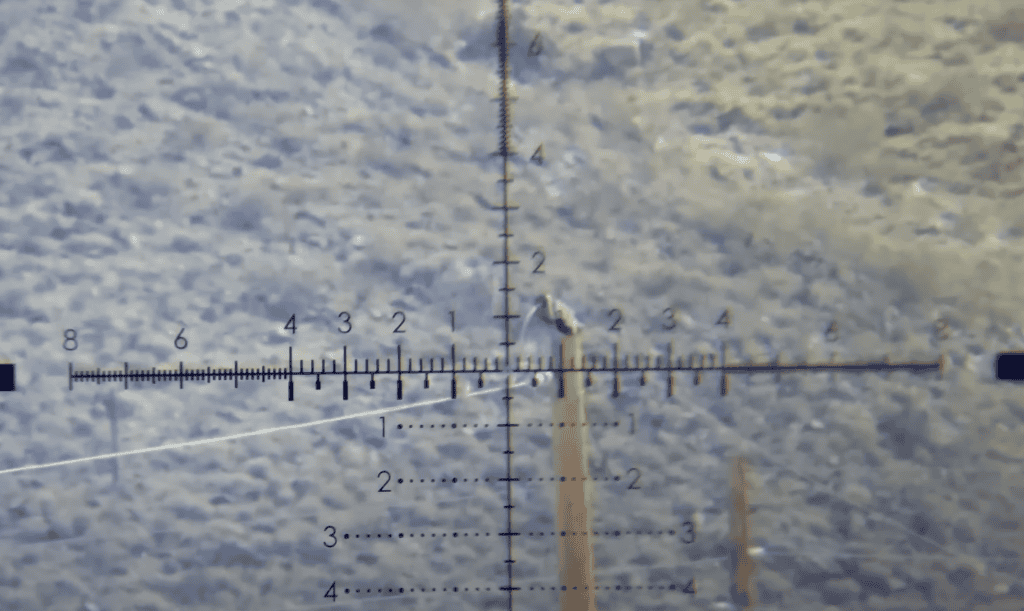
But here’s what that means in practice: at 3x, the reticle gets thin. Really thin. Against shadowed brush during that coyote stand, I could barely see the crosshair. The Athlon’s illuminated FFP reticle would have been clearer. At 15x, the reticle was plenty visible, but I was wishing for more magnification rather than appreciating the reticle detail. The FFP design is the right choice for the varying distances in varmint work, but without illumination, it’s hard to use effectively at low power in less-than-perfect light.
Turrets and That Massive Adjustment Range
The elevation turret is exposed with positive clicks—25 MOA per revolution, clearly marked. I ran it through a tracking test and it returned to zero within 0.1 MOA after a 20 MOA box. The 124 MOA total elevation is absurd overkill for the .22-250. Even without a rail, I’d never use half that adjustment. It’s nice knowing I’ll never hit a limit, but it’s solving a problem that doesn’t exist for this cartridge.
The capped windage turret was frustrating. Texas wind shifts constantly during prairie dog sessions, and removing a cap, making adjustments, and replacing the cap slowed me down compared to the dual-exposed turrets on the Athlon and Diamondback. I get that Vortex wanted to protect the windage from bumps, but for varmint work where you’re adjusting frequently, exposed windage is faster.
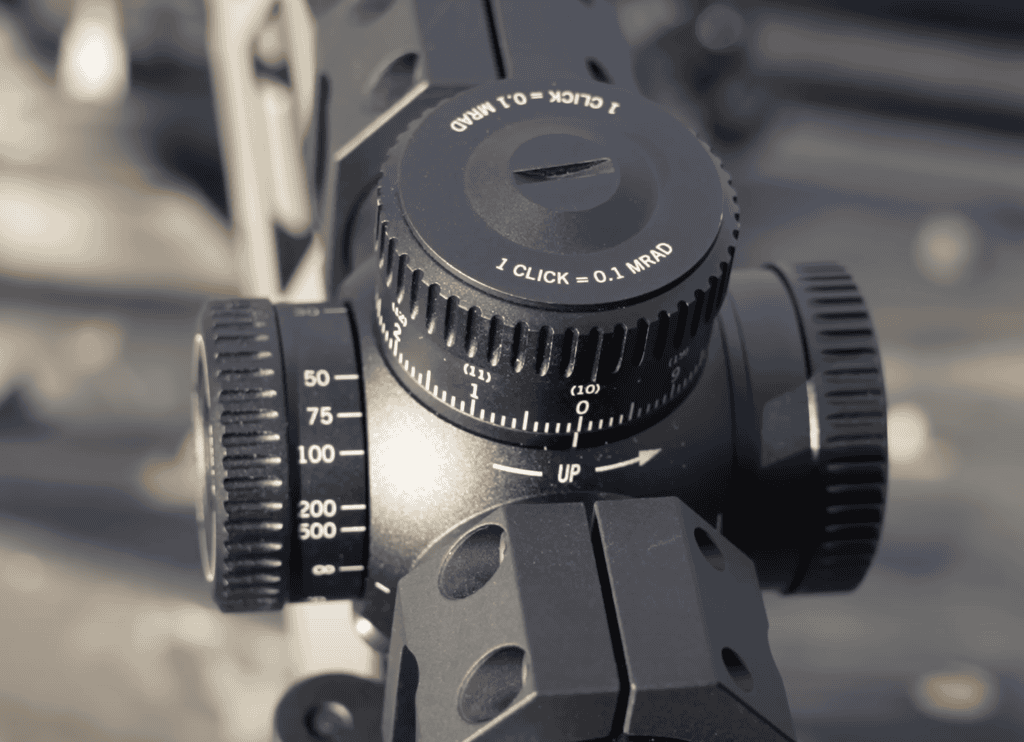
Weight That Doesn’t Match Performance
At 28.8 oz, the Venom weighs nearly as much as the Athlon despite topping out at 15x instead of 24x. That 34mm tube and massive internal adjustment mechanism add weight. On my heavy-barreled Savage, the weight wasn’t a handling issue. But I kept thinking: if I’m carrying this much scope weight, I want the magnification to match. The Diamondback Tactical gives me 6-24x at 24.6 oz—lighter and more capable. The Venom’s weight-to-magnification ratio doesn’t make sense for this application.
The glass quality is solid—comparable to the Diamondback Tactical. Clear center with decent edge sharpness, good color rendition, adequate brightness in low light. The 3.7 inches of eye relief stayed consistent across the zoom range, which made it easier to maintain a sight picture than the Leupold’s variable eye relief. But good glass at 15x doesn’t help when you need 20x to see prairie dog vitals at 450 yards.
Field Test Data
| Test Parameter | Result |
|---|---|
| 100-Yard Zero Confirmation | 0.8 MOA 5-shot group from bipod |
| Tracking Accuracy (Box Test) | Returned to zero within 0.1 MOA after 20 MOA box |
| Maximum Confirmed Hit | Prairie dog at 412 yards, struggled to see clearly at 15x |
| Close-Range Performance | Excellent 3x low end for acquiring close targets quickly |
| Turret Feel | Exposed elevation turret with positive clicks, 25 MOA per revolution |
Tested with: Savage 12 Varminter | Hornady Varmint Express 55gr V-MAX
Pros and Cons
PROS
|
CONS
|
Performance Ratings
Learn more about how I test and rate scopes.
The Venom delivers premium features—34mm tube, massive adjustment range, FFP reticle—but the 15x magnification stops short of what the .22-250 demands for long-range varmint work. If you’re using the cartridge primarily for coyotes inside 350 yards with occasional longer shots, the Venom’s versatile 3-15x range works well. But for serious prairie dog hunting where 400-500 yard shots are routine, the 6-24x scopes provide the magnification this flat-shooting cartridge deserves.
How I Actually Tested These Scopes
I mounted all four scopes on my Savage 12 Varminter—a heavy-barreled .22-250 with a 1:12 twist that’s killed more prairie dogs than I’ve bothered counting. Testing ran from mid-April through early July, primarily on private land outside Amarillo where prairie dog towns stretch for acres and coyotes show up most mornings if you’re patient.
I shot approximately 300 rounds of Hornady Varmint Express 55gr V-MAX through the testing period—roughly 75 rounds per scope. Each scope got zeroed at 100 yards, then I ran a 20 MOA box test to confirm tracking before taking it into the field. Distances ranged from 150-yard coyote shots to prairie dogs pushed past 500 yards when mirage allowed.
I rejected two scopes during preliminary testing. A Barska Blackhawk 6-24×50 that shifted zero after 40 rounds went back immediately. The second was a Centerpoint 6-24×50 that had decent glass for the price but the parallax adjustment seized up after two weeks of testing in Texas heat. Couldn’t adjust it past 200 yards, making it useless for long-range prairie dog work
Weather during testing varied from cool spring mornings in the 50s to brutal July afternoons pushing 100 degrees. The hottest days created mirage that limited effective range regardless of scope quality, but they also revealed which scopes maintained zero through temperature swings and which ones stayed clear internally despite heat.
I used a Harris 9-13″ bipod for most shooting and confirmed zero after swapping scopes by shooting five-round groups from that bipod at 100 yards. The Savage consistently shoots sub-MOA with this ammunition when I do my part, so any groups opening up beyond an inch told me something about either the scope’s clarity or my ability to see through it.
Get more information on how I test optics here.
What Hunters Get Wrong About .22-250 Scopes
Thinking 12x is Enough Magnification
The .22-250 shoots flat to 500 yards with minimal drift. Prairie dogs at that distance are small—maybe 8 inches tall when sitting up. At 12x magnification, you’re guessing at vitals. At 20x or 24x, you can actually see what you’re aiming at. This isn’t about overkill; it’s about using the cartridge’s capability. If you’re genuinely staying inside 300 yards, fine, 12x works. But don’t handicap a 500-yard cartridge with a 300-yard scope.
Assuming Capped Turrets Work for Varmint Shooting
Capped turrets make sense on a deer rifle where you zero at 200 yards and hold for everything else. For varmint work with the .22-250, you’re dialing corrections constantly—250 yards, then 380, then back to 200, then out to 450. Removing and replacing turret caps between shots is maddening. Exposed turrets with zero reset or zero stop systems let you work fast without fumbling caps.
Buying Scopes Without Checking Adjustment Range
The .22-250’s flat trajectory is a blessing until you realize some scopes don’t have enough internal adjustment to dial out to the cartridge’s effective range. Before buying, verify the total elevation range works for how you’ll use the rifle. For reference: if you’re planning to dial corrections past 400 yards with standard loads, you’ll need adequate adjustment paired with an appropriate rail. A scope with limited range forces you into holdover shooting where the cartridge’s flat trajectory should let you dial precisely. Match the scope’s adjustment capability to your intended use rather than assuming any scope will work.
Picking FFP Scopes Without Understanding the Trade-off
First focal plane reticles scale with magnification, which means subtensions stay accurate at any power. That’s useful. But it also means the reticle gets finer as you zoom out, which can make it disappear against certain backgrounds at low power. For the .22-250, FFP makes sense because you’re shooting at varying distances. Just understand that the reticle you see at 6x will be thinner than the one you see at 24x. Illumination helps with this, which is why the Athlon’s illuminated FFP reticle worked better than the Vortex’s non-illuminated FFP in low light.
Your Questions Answered
Do I need exposed turrets or will holdover work with the .22-250?
Exposed turrets make varmint shooting with the .22-250 faster and more precise. The flat trajectory means you’re not dealing with huge corrections, but you are making constant small adjustments as distances change. Dialing is more accurate than memorizing holdovers for every 25-yard increment.
What magnification range actually makes sense for .22-250 varmint work?
A 6-24x or 6.5-20x range fits the cartridge’s capability. The 6x low end handles close coyotes, while 20-24x high end lets you precisely place shots on prairie dogs past 400 yards. Anything less than 16x on the top end leaves you short when you’re trying to push the cartridge’s effective range.
Is FFP or SFP better for the .22-250?
FFP reticles stay accurate at any magnification, which suits the .22-250’s versatility—close coyotes to distant prairie dogs. SFP reticles are simpler and often clearer, but subtensions only work at maximum magnification. For pure prairie dog work where you’re always at high power, SFP is fine. For mixed hunting, FFP provides more flexibility.
How much elevation do I really need in a scope for this cartridge?
The answer depends on how you’ll use the rifle and your rail setup. For long-range prairie dog work where you’re dialing to 500+ yards, you’ll want sufficient adjustment paired with a canted rail. A scope designed for this application typically provides adequate range when properly mounted. If you’re staying inside 350 yards or planning to use holdovers, you can work with less. The key is matching the scope’s adjustment capability to your intended shooting distances rather than picking a random number.
Which Scope for Your Hunting Style?
Long-Range Prairie Dog Hunter: The Athlon Argos BTR Gen 3 is what you need. That 6-24x range with FFP reticle and true zero stop handles rapid elevation changes across dog towns. The illumination helps during early morning sessions, and the 60 MOA adjustment works to 500 yards with a 20 MOA rail.
Walking Varmint Hunter: Go with the Vortex Diamondback Tactical. At 24.6 oz, it’s six ounces lighter than the Athlon—which matters when you’re covering miles to reach shooting positions. You lose illumination, but you gain a more forgiving eyebox and slightly more adjustment range. The VIP warranty means you never worry about breaking it in the field.
Close-Range Coyote Hunter in Thick Cover: The Leupold VX-Freedom fits your needs better than the tactical scopes. That 4x low end with generous eye relief lets you acquire coyotes fast at 50-150 yards. The superior Leupold glass helps in low light when coyotes are moving. Just accept that prairie dogs past 350 yards won’t be this scope’s strength.
Versatile Hunter Mixing Close and Mid-Range Work: The Vortex Venom fits if you need one scope for coyotes at 50 yards and prairie dogs at 350. That 3-15x range with FFP reticle covers both scenarios. The 124 MOA adjustment means you’ll never run out of elevation. Just accept that prairie dogs past 400 yards won’t be this scope’s strength—the 15x magnification becomes the limiting factor at distance.
Disclosure
I purchased all four scopes in this review with my own money specifically for this test. When you buy through links on this site, I may earn a small commission at no cost to you. This helps support the testing work, but it doesn’t influence what I recommend—I test gear the same way whether I’m earning commissions or not. If a scope underperforms, I’ll tell you regardless of any business relationship.
Final Thoughts
The .22-250 shoots flat, fast, and far. It’ll reach prairie dogs at ranges where most varmint cartridges are already dropping hard. But that capability gets wasted if you mount a scope that can’t keep up. During this test, the difference between adequate magnification and insufficient magnification became obvious past 400 yards—the Athlon and Vortex let me work confidently at distances where the Leupold had me straining. The Venom’s magnification limitation was frustrating—I could dial the elevation precisely, but at 15x I couldn’t see prairie dog vitals clearly enough past 400 yards to know where to aim.
The Athlon Argos BTR Gen 3 earned the top spot because it addresses every challenge the .22-250 presents. The 6-24x magnification matches the cartridge’s range. The FFP reticle works at any power. The true zero stop makes rapid elevation changes foolproof. The illumination handles low-light work. It’s not the lightest scope here, but for a heavy-barreled varmint rifle that spends time on a bipod rather than being carried for miles, that weight penalty doesn’t matter. The Vortex Diamondback runs it close for shooters who prioritize light weight over illumination, but the Athlon’s feature set at its price tier is hard to beat.
You can also check which are the best scopes for Ruger 10/22 and Marlin 60. Or if you are looking for something more powerful, check which are the best .308 scopes.
The right scope makes the .22-250 into what it should be—a precision tool for long-range varmint work. The wrong scope turns it into just another rifle that shoots fast but can’t capitalize on its accuracy. Test your gear hard, know what it can do, and don’t settle for inadequate optics on a cartridge this capable.
Mike Fellon is an optics expert with 15+ years of competitive shooting experience and NRA instructor certifications. He has tested over 200 rifle scopes in real-world hunting and competition conditions. Based in Dallas, Texas.

